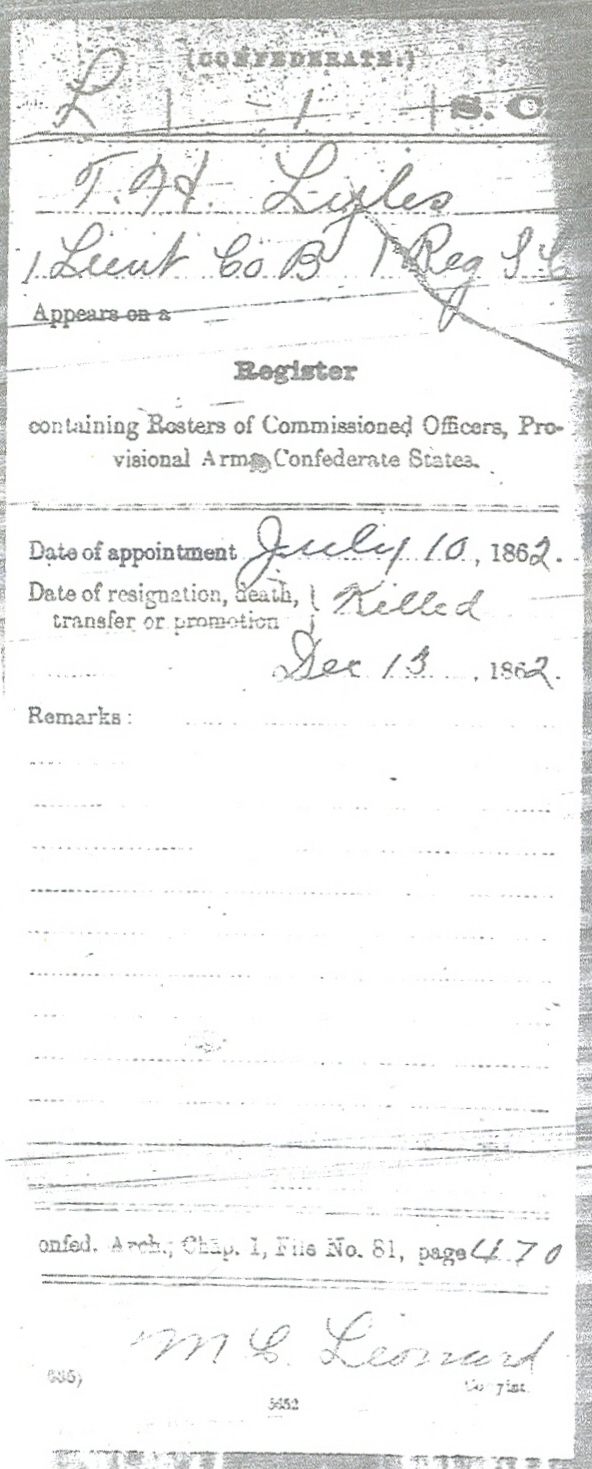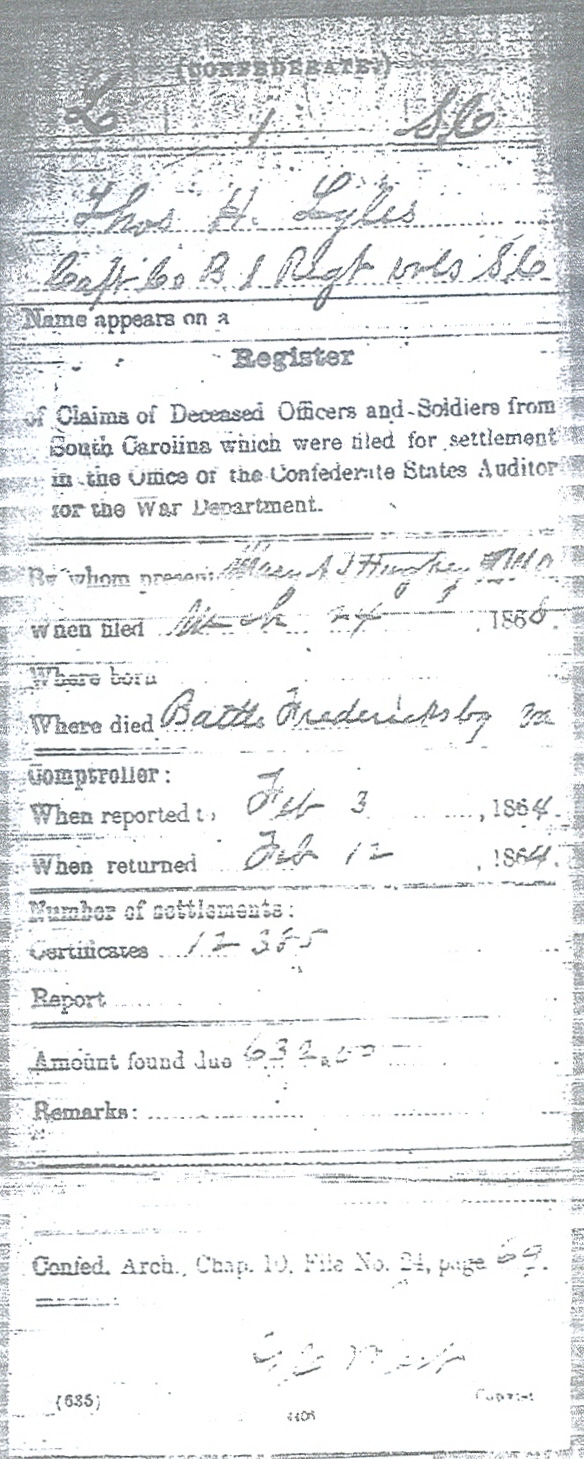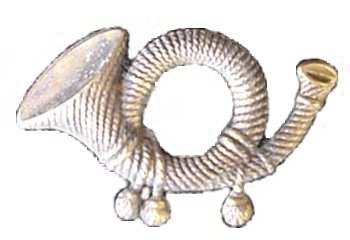|
Thomas Henry Lyles, (my great, great, grand uncle), was born in Mulberry District, Fairfield County, South Carolina May 17, 1840. He was the son and 3rd child of Mary Adeline T. Lake and Thomas Middleton Lyles. After the death of Mr. Lyles, Mary married Daniel Webster Hughey, (my great-great grandfather), on July 25, 1850. With this marriage Mr. Hughey assumed custody of the five Lyles children, including Thomas H. Lyles, who was then age 10. They resided in Newberry County where they were substantial farmers and slaveholders with the responsibly and care of sixty-seven souls. [1]
Upon South Carolina's Secession from the Union she called on her sons to form a state army for her defense.
Filled with zeal for the cause, Thomas Henry, then 20 years old, traveled to the county seat and volunteered to fight. He became a volunteer in Company "B", (Rhett Guards) 1st South Carolina Volunteer Infantry, Provisional Army and was enlisted on the 5th of January 1861 for six months.
Thomas Henry Lyles left no correspondence or letters which have been discovered to date that would shed light on his service to the Confederacy. The following account is based on Confederate records and the activities of his Company and Regiment and the hostilities that took place in their area.
The original 1st Regiment South Carolina Volunteer Infantry unit mustered in at Columbia, South Carolina, as part of the provisional army. They were sent to Charleston, and were part of the forces massed in preparation to force the surrender of Fort Sumter. At their first arrival in Charleston they were sent over to Sullivan's Island, and quartered at the Moultrie House. There they were organized with ten other companies into a regiment, of which Maxey Gregg was appointed Colonel. One cold day, about the middle of January, orders were issued transferring the regiment to Morris Island. Morris Island was then commanded by Colonel J. Johnson Petigrew, of the First Regiment of Rifles, South Carolina Militia.
A day or two before the bombardment of Fort Sumter commenced, General James Simons was sent to Morris Island, and assumed immediate command of the troops on that island. Pursuant to his orders, Colonel Gregg's regiment was deployed towards the southern end of the island.
After the formation of the Confederate States of America they were transferred to Virginia to defend the capital at Richmond.
Most of the officers and men that served in the 1st South Carolina Volunteers, had signed up for a six-months. So that command was mustered out of service in late July in order to be reorganized for the duration of the war. It was at this time that Thomas Henry Lyles was elected 2nd Lt. with an appointment date of August 17, 1861. [2]
  Regimental Flag Battle Flag
Regimental Flag Battle Flag
The 1st S.C. Infantry Regiment, Provisional Army completed its reorganization at Richmond, in August, 1861. They became a part of Maxcy Gregg's Brigade, A.P. Hill's Division, Army of Northern Virginia. The regiment was made up of 11 companies, but Company D, the Pee Dee Rifles, was converted to an artillery unit known as McIntosh's Battery or the Pee Dee Light Artillery.
They fought with the Army of Northern Virginia first at Seven Days', (June 25 to July 1, 1862), (Battles of Frazier's Farm, Oak Grove, Gaines' Mill, Malvern Hill).
In these engagements the regiment lost 20 killed and 133 wounded.
After these battles, Lyles was promoted to 1st Lt. on July 10, 1862. [2]
The 1st SCVI Regiment later suffered fifty-three percent disabled of the 283 engaged at Second Manassas, (August 27-30, 1862), and Ox Hill. On the 29th at Second Manassas, the fury of Gen. Pope's attacks fell on Jackson's left, held by A. P. Hill; and here Gregg's brigade of South Carolinians fought with unsurpassed courage from morning till late in the afternoon. More than six hundred of his one thousand, five hundred men had fallen around the heroic Gregg, when, with ammunition exhausted, he replied to General Hill that he “thought he could still hold his position with the bayonet.” General Hill, in his after action report, states that, "The stubborn tenacity with which Gregg's brigade held its position this day (29th) is worthy of highest commendation".
General Jackson reports the brigade of General Gregg, which, from its position on the extreme left, was most exposed to the enemy's attack, had nearly expended its ammunition. It had suffered severely in its men, and its field officers, except two, were killed or wounded.’ One of those fallen officers was Thomas H. Lyles' brother-in-law 1st Lt. William M. Hatton.
At the Battle of Sharpsburg, (September 17, 1862), the 1st S.C. V.I. along with the rest of A.P. Hill's Division made a forced march from Harper's Ferry; arriving just in the nick of time to turn back Burnside's attack on Lee's right flank, saving Lee's army form certain destruction at the hands of the Federals. The regiment had 4 killed and 30 wounded at Sharpsburg.
Lee's army then crossed the Potomac and returned to the safety of Virginia, but was soon once again on the march to defend their country from invasion. The Union army, now under Maj. Gen. Ambrose Burnside was once again moving on Richmond. They had stopped on the N. East back of the Rappahannock River opposite Fredericksburg.
On the morning of Dec 13th, 1862, as acting captain, Thomas Henry Lyles would have been busy positioning his men at on a ridge line south of Fredericksburg, Va. as part of "Stonewall" Jackson's II Corp. Opposing then was Maj. Gen. Franklin's I Corp.
Burnside had reinforced Franklin's sector on the morning of battle to a strength of some 60,000 men. Franklin, designated Major General George G. Meade's III Division to spearhead the combined attack.
Meade and Gibbon, two brave and capable commanders, supported by fifty-one guns, would lead the attack. A skillful reconnaissance by the Federal engineers had discovered that a tongue of forest, extending from the front of that highland well out into the plain, and near A. P. Hill's left, had been left unguarded, on the supposition that its swampy character would prevent its use as an approach. Through this weak and concealing point, the Federal advance would come in an attempt to turn Jackson's left flank.
By 10 a.m., a thick fog began to lift, and the initially sluggish movements picked up speed. Meade's division formed the main attack, supported by the I and II Divisions of Brig. Gen. Abner Doubleday and Brig. Gen. John Gibbon. The attack was temporarily stalled by the Virginia Horse Artillery under Major John Pelham, and an artillery duel between Pelham and the Union artillery batteries lasted for about an hour.
As Meade finally made traction as they pushed through the boggy forest into the South Carolinians of Brig. Gen. Maxcy Gregg's brigade, A. P. Hill's first line of battle. Greg first mistook the attackers for retreating Confederates, and he paid dearly for this error and was mortally wounded defending his ground by mini ball through his spine. Meade's men rolled forward and gained the crest of the heights as they overwhelmed, broke and scattered the Confederate first line. Gen. Gregg gave up his life in attempting to stem, with the second line, the oncoming Federal tide of attack. He died two days later in hospital.
It was probably at this very time that the valiant Thomas Henry Lyles lost his young life. The regiment sustained 73 casualties at Fredericksburg, one of which was then acting Captain Thomas Henry Lyles. [3]
Today's society does not comprehend the hardships, sacrifices and devastation this war had upon southerners. It certainly was devastating to my great-great grandfather and great-great grandmother. Not only did they lose a promising son Thomas Henry Lyles and a beloved son-in-law, William M. Hatton, they had their family plantation destroyed, along with all its contents and a family owned and operated ferry across the Broad River was burned and destroyed.
Thomas and William rest peacefully today in the Lyles - Hughey family cemetery in Newberry County. Thomas next to his mother Mary and William next to his wife Lucy Lyles Hatton.
The cemetery is located between Cannon's Creek and Heller's Creek on the Broad River, just above Peak, S. C. Thomas' tombstone reflects his brief time as acting Captain.


IN
memory of
Capt. THOMAS H. LYLES
who was born
May 17, 1840
and was killed in the
battle of Fredericksburg
Dec'r 13th, 1862. |
|
|

OUR MOTHER
MARY A. T. HUGHEY
Wife of
Daniel Hughey
BORN
Dec. 1, 1815
DIED
Feb. 8, 1886
|
|

IN
memory of
Lieunt. Wm. M. HATTON
who was born
8th Jan'y 1827.
and was killed in the
battle of Manassas
30th August 1862 |

1st South Carolina Volunteer Infantry
OFFICERS:
Colonels:
Maxey Gregg - Daniel H. Hamilton - Charles W. McCreary
Lieutenant Colonels:
T. Pinckney Alston - Andrew P. Butler - Edward McCrady, Jr. -
Washington P. Shooter - Augustus M. Smith
Major:
Edward D. Brailsford.
BATTLES:
Fort Sumter SC (12 - 13 APR 1861)
Vienna (17 JUN 1861)
Seven Days Battles, VA (25 JUN - 1 JUL 1862)
2nd Bull Run, VA (28 - 30 AUG 1862)
Antietam, VA (17 SEP 1862)
Shepherdstown Ford (20 SEP 1862)
Fredericksburg, VA (13 DEC 1862)
Reg. actions after Capt. Lyle's death
Chancellorsville, (1-4 MAY 1863)
Gettysburg, PA (1-3 JUL 1863)
Falling Waters (14 JUL 1863)
Bristoe Campaign (9 - 22 OCT 1863)
Mine Run Campaign, VA (NOV - DEC 1863)
The Wilderness, VA (5 - 6 MAY 1864)
Spotsylvania Court House, VA (8 - 21 MAY 1864)
North Anna, VA (23 - 26 MAY 1864)
Cold Harbor, VA (1 - 3 JUN 1864)
Petersburg Siege, VA (JUN 1864 - APR 1865)
First Squirrel Level Road, VA (30 SEP 1864)
Jones Farm, VA (30 SEP 1864)
First Pegram's Farm, VA (1 OCT 1864)
Five Forks, VA (1 APR 1865)
ROSTERS:
Rivers account states that the original recruitment of this regiment was 1,059 men including officers.
Field Staff and Band
Company A - Richland Rifles
Company B - Darlington (Rhett) Guards
Company C - Edgefield Rifles
Company D - Abbeville Volunteers
Company E - Union Volunteers
Company E - after the reorganization
Company F - Wee Nee Volunteers - Williamsburg County
Company F - Horry Rebels
Company G - before the reorganization
Company G - after the reorganization
First Company H - Cherokee Ponds Guards
Company H - Cherokee Pond Volunteers
Company I - Monticello Guards
Company K - Marion Volunteers
Company L - Rhett Guards - Newberry County
William H. Campbell's Company
FOOT NOTES:
[1] U.S. Census and other family data.
[2] State Archives: Promotions...


[3] State Archives: Death ....


[4] Order of battle:
DECEMBER 11-15, 1862.--Battle of Fredericksburg, Va.
O.R.-- SERIES I--VOLUME XXI [S# 31]
Gen. ROBERT E. LEE,
Commanding
SECOND CORPS.
Lieut. Gen. THOMAS J. JACKSON.
A. P. HILLS DIVISION.
Maj. Gen. AMBROSE P. HILL.
Second Brigade.
(1.) Brig. Gen. MAXCY GREGG.
(2.) Col. D. H. HAMILTON.
1st South Carolina (P. A.), Col. D. H. Hamilton.
1st South Carolina Rifles.
12th South Carolina.
13th South Carolina.
14th South Carolina, Col. Samuel McGowan.
|

